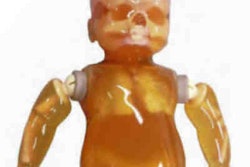
Point-of-care ultrasound (POCUS) is an effective alternative to conventional x-ray when it comes to localizing small-bore percutaneously inserted central catheters, according to Italian research published December 28 in the Journal of Pediatrics.
A team led by Dr. Fiorentino Grasso from Federico II University in Naples said POCUS is also noninvasive compared with radiography, making it ideal for newborn child patients.
"We conclude that clinicians certified in POCUS can accurately identify catheter tip in this cohort of preterm neonates and enhance safety of care," Grasso and colleagues said.
For newborn patients in critical condition, a central venous catheter may be needed for drug administration and nutrition. A percutaneously inserted central catheter is typically used. It is made of a small-bore silicone or polyurethane device and is inserted through the superficial veins of the limbs, the neck, or the scalp.
A radiograph is the standard imaging method used to assess the catheter tip location. However, this method uses ionizing radiation.
Ultrasound has been suggested in previous research as a good alternative to radiographs by being radiation-free and a repeatable bedside option for experienced clinicians, the team said. POCUS, meanwhile, has been touted by researchers for its portability and cost-effectiveness, while having accuracy comparable with that of standard ultrasound.
Grasso et al wanted to see if POCUS could help with guiding catheter tip location in newborn patients. They studied 118 percutaneously inserted central catheters in 102 newborns with an average postmenstrual age of 31 weeks. The average weight of the newborns at positioning was 1,365 grams.
The investigators found that the feasibility of POCUS-guided tip location was 92.3%. Failures were significantly associated with mechanical ventilation with an average odds ratio of 5.33 (p = 0.038).
The team also found agreement between ultrasonic and radiographic methods in 88 out of 109 cases (80.7%). Out of the 21 discordant cases, 15 led to a change in clinical management.
The study authors touted that ultrasound allows for imagers to directly visualize catheters within vessels, while radiologists estimate catheter tip position by relying on proxy, extravascular landmarks. They also pointed out that POCUS had an imaging time quicker than that of x-ray film. They said that the longest duration of a scan with POCUS was five minutes, compared with the 32-minute average for a chest x-ray film.
The researchers called for multicenter studies to validate these results, saying that future research to monitor catheter dislodgement could also expand the utility of POCUS for catheter management.
"POCUS-guided localization of small bore percutaneously inserted central catheters is a non-invasive and effective alternative to the conventional radiogram," they said. "The latter should be recommended when ultrasound fails to locate the catheter tip."



















